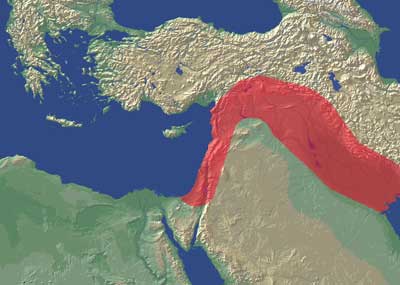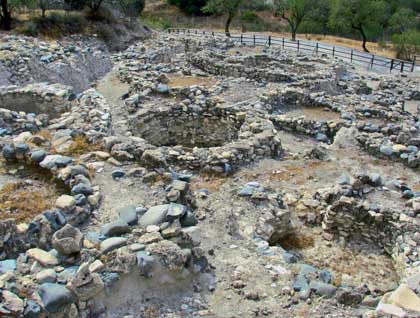
Around ten thousand years ago, as the last Ice Age came to an end, a radically new lifestyle appeared in the Middle East. It was based on agriculture rather than hunting and foraging, which had predominated in the region up until then and involved small family groups of a dozen or so people following herds of large, migratory animals over great distances, supplementing their diet with whatever fruits, nuts and edible roots they came across along the way. It was an extremely 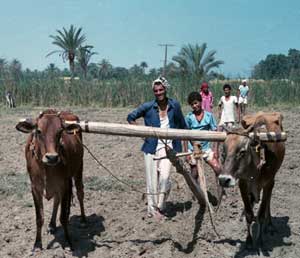 rough life and one with little room for passengers. Agriculture meant concentrating the energies of the group on controlling the propagation of a few select species of plants and animals. By about 4000 BC the practice had reached the British Isles.
rough life and one with little room for passengers. Agriculture meant concentrating the energies of the group on controlling the propagation of a few select species of plants and animals. By about 4000 BC the practice had reached the British Isles.
The region known to archaeologists as the Fertile Crescent includes Mesopotamia and the Levant along with the adjacent hill country (map right). Here, post-Pleistocene climate change brought about the onset of warmer, drier conditions, which put an enormous amount of pressure on the people who lived in the area. Fortunately for them, growing in dense stands, were a number of wild grasses whose seeds were rich in nutrients— ancestral strains of modern wheat and barley.
The grain ripened at specific times of the year and required a lot of effort to bring in enough to sustain the group over the course of a year. Grain could be stored for a year or so, as long as it was kept dry (to inhibit germination) and away from vermin, but the bulk required was such that permanent storage facilities were necessary, which meant settling at a single location for the the whole year. With permanent or semi-permanent settlement, domestication followed. 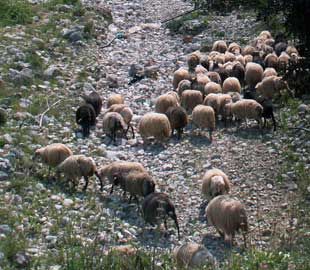
Domestication involves creating an artificial set of circumstances so that the selected species (plant or animal) becomes dependant on human activity in order to survive and propagate. This involved preparing the ground and sowing it with seeds, selected for their size and yield that had been held back from the previous year’s harvest, radically transforming the local ecosytem.
A more sedentary lifestyle meant that it was harder and harder to obtain animal protein for the group as game animals became wary and kept clear of the village. Either they had to be pursued in ever more far-flung hunting expeditions or enticed to stay close at hand. Of all of the targeted animals, two species in particular proved amenable to domestication—sheep and goat. Both were herd animals that were led by a dominant male, a role that was taken over by the herdsman who offered the flock regular food and protection from predators. By selectively slaughtering the more aggressive individuals, he soon brought the rest under complete control.
Sedentism has a number of drawbacks, most of them having to do with population growth. Whether or not demographic pressure was a cause of the ‘neolithic revolution,’ it certainly was an effect. Now that the group no longer had to make extended marches, mothers could handle more than one or two children at a time and consequently families grew ever larger. Initially, it was not much of a problem—many hands made light work—but eventually numbers grew beyond the capacity of the available land to support them.
The advantages of farming were not immediately apparent. It required much mork work to produce a diet that was less varied and far less nutritious than before. Wheat and barley had to be ground into flour in order to be digestible and skeletal evidence shows that women in particular were subject to severe osteoarthritis in the toes, the knees and the lower back from having been 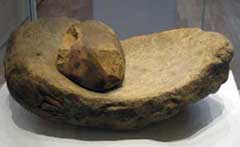 hunched over a primitive 'saddle; quern (left) every day for long hours to grind enough grain to feed her family. In addition, the process left so much grit in the flour that most people’s teeth had worn down to the nerve by the time they reached their twenties making it difficult to digest much more than mush and gruel.
hunched over a primitive 'saddle; quern (left) every day for long hours to grind enough grain to feed her family. In addition, the process left so much grit in the flour that most people’s teeth had worn down to the nerve by the time they reached their twenties making it difficult to digest much more than mush and gruel.
The level of hygiene would have been low to say the least. Surrounded by their livestock, they lived the midst of their own steadily increasing filth and debris. Infectious diseases, many of them communicated from their animals, took a heavy toll and would have killed off whole communities. Population continued to rise nonetheless, and eventually exceeded the capacity of the local environment to support it. The possible responses were limited. They could intensify their exploitation to maximize yield, or they could restrict their numbers through birth control, abortion and infanticide, or they might divide the community and send part of the group to colonize another area. The latter was the more successful option and resulted in the spread of farming through Anatolia, into the Balkans and from there to the rest of Europe.
19.05.2015

